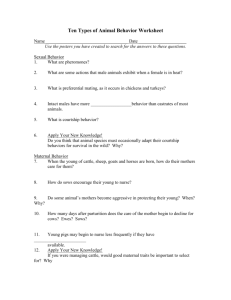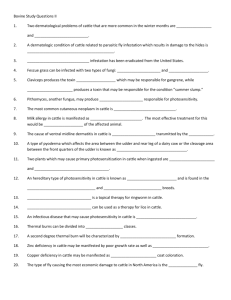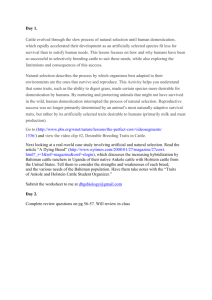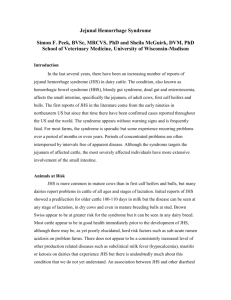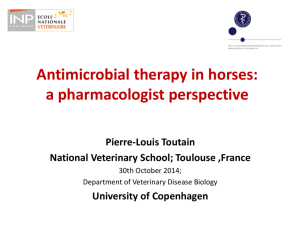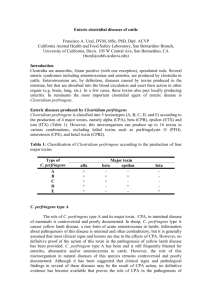eprint_2_6604_114
advertisement
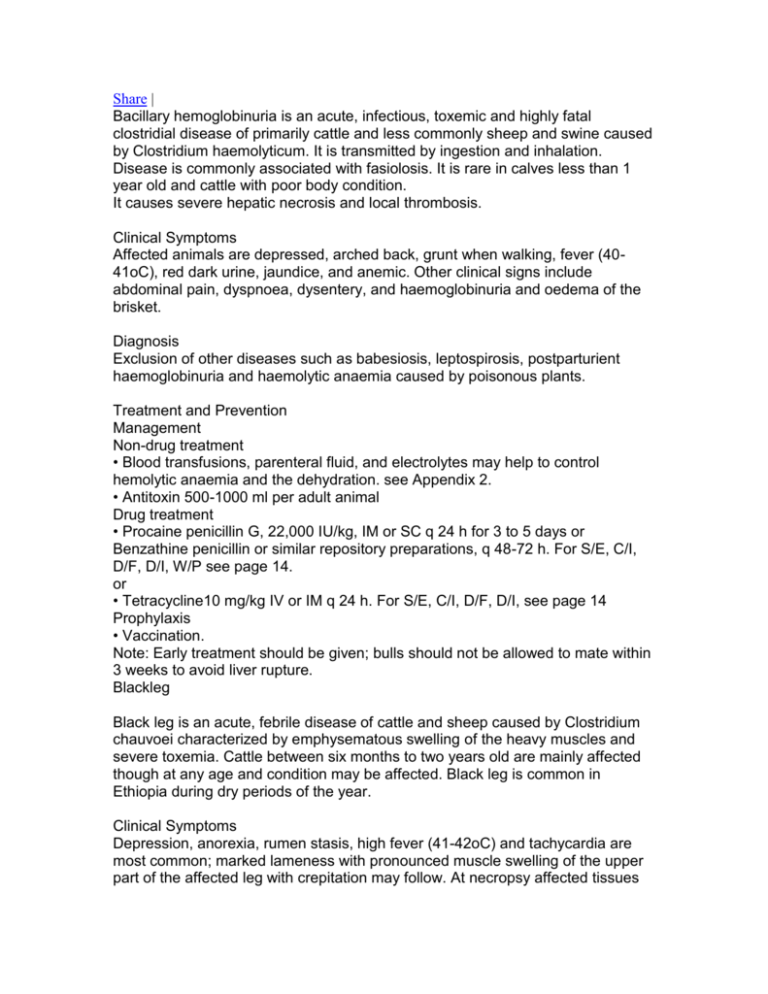
Share | Bacillary hemoglobinuria is an acute, infectious, toxemic and highly fatal clostridial disease of primarily cattle and less commonly sheep and swine caused by Clostridium haemolyticum. It is transmitted by ingestion and inhalation. Disease is commonly associated with fasiolosis. It is rare in calves less than 1 year old and cattle with poor body condition. It causes severe hepatic necrosis and local thrombosis. Clinical Symptoms Affected animals are depressed, arched back, grunt when walking, fever (4041oC), red dark urine, jaundice, and anemic. Other clinical signs include abdominal pain, dyspnoea, dysentery, and haemoglobinuria and oedema of the brisket. Diagnosis Exclusion of other diseases such as babesiosis, leptospirosis, postparturient haemoglobinuria and haemolytic anaemia caused by poisonous plants. Treatment and Prevention Management Non-drug treatment • Blood transfusions, parenteral fluid, and electrolytes may help to control hemolytic anaemia and the dehydration. see Appendix 2. • Antitoxin 500-1000 ml per adult animal Drug treatment • Procaine penicillin G, 22,000 IU/kg, IM or SC q 24 h for 3 to 5 days or Benzathine penicillin or similar repository preparations, q 48-72 h. For S/E, C/I, D/F, D/I, W/P see page 14. or • Tetracycline10 mg/kg IV or IM q 24 h. For S/E, C/I, D/F, D/I, see page 14 Prophylaxis • Vaccination. Note: Early treatment should be given; bulls should not be allowed to mate within 3 weeks to avoid liver rupture. Blackleg Black leg is an acute, febrile disease of cattle and sheep caused by Clostridium chauvoei characterized by emphysematous swelling of the heavy muscles and severe toxemia. Cattle between six months to two years old are mainly affected though at any age and condition may be affected. Black leg is common in Ethiopia during dry periods of the year. Clinical Symptoms Depression, anorexia, rumen stasis, high fever (41-42oC) and tachycardia are most common; marked lameness with pronounced muscle swelling of the upper part of the affected leg with crepitation may follow. At necropsy affected tissues are filled with rancid serosanguineous fluid and gas pockets, which crepitate when squeezed and the muscle appear dry. Diagnosis The clinical signs and postmortem findings are indicative; the epidemiology and bacterial isolation are confirmatory. Treatment and Prevention Management Non-drug treatment • Drainage and slashing of affected tissue to allow oxygen into the tissue plus supportive treatment with parenteral fluids, analgesics, etc. Drug treatment • Procaine penicillin G, 22,000 IU/kg, IM or SC q 24 h for 3 to 5 days or Benzathine penicillin or similar repository preparations, q 48-72 h. For S/E, C/I, D/F, D/I, see page 14 plus • Local antibiotic treatment eg.Oxytetracyline spray 5% at the site of the wound is helpful. Prevention • Vaccination with C. chauvoei bacterin. Botulism This rapidly fatal motor paralysis is caused by ingestion of preformed toxin of Clostridium botulinum from decaying carcasses or vegetable materials such as decaying grass, hay, grain, or spoiled silage. Ingestion of botulism toxin from decaying tortoise carcasses has been reported in Bale zone, southern Ethiopia. Clinical symptoms Decreased tongue tone that protrudes out and problems associated with deglutition and prehension of food, followed by progressive muscular weakness until animals become recumbent in a parturient paresis-like posture, ataxia and stumbling gait affecting the hind legs are commonly observed. Diagnosis Commonly, the diagnosis is made by eliminating other causes of motor paralysis and look for potential sources of toxin. Treatment and Prevention Management Drug treatment • Ruminal lavage, followed by 50-80 ml lactic acid in 5-10 L of water per stomach tube in adult cattle • Polyvalent anti-C and anti-D antisera (if available) Control • Correction of dietry deficiencies and proper disposal of carcass. Removal of decaying grass or spoiled silage from cattle feed is indicated.



